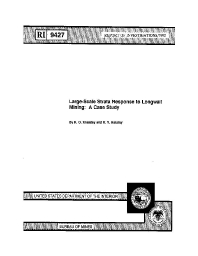 |
This U.S. Bureau of Mines report summarizes a study of large-scale strata response to longwall mining at a western U.S. coal mine. This study utilized surface and subsurface measurements, geologic mapping, in situ stress measurements, and pressure cell readings to characterize strata behavior. Preliminary analysis of surface subsidence and time-domain reflectometry (TDR) was used to determine a suggested main roof caving sequence. Coal ejected from the face apparently resulted from brittle failures that occurred because of lack of significant yield zone development. The combination of a strong coal with pronounced directional behavior, low overburden pressures, a good caving roof, and a high-production environment that minimized time-dependent loading apparently reduced yielding of the longwall face. The panel 1 headgate-entry design appears adequate; however, the abutment pillar and adjacent panel tailgate rib are highly stressed and may contribute to problems during second panel mining. The small chain pillar yielded after passage of the face, but the pillar width may be near maximum since evidence of a stressed core exists.
| Author(s): | Kneisley-RO, Haramy-KY |
| Reference: | U.S. Department of the Interior, Bureau of Mines, Report of Investigations 9427, 1992:1-25 |
ri9427 (PDF, 1429 KB)